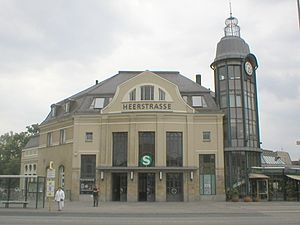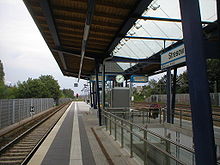Spandau suburban railway
| Spandau suburban railway | |||||||||||||||||||||||||||||||||||||||||||||||||||||||||||||||||||||||||||||||||
|---|---|---|---|---|---|---|---|---|---|---|---|---|---|---|---|---|---|---|---|---|---|---|---|---|---|---|---|---|---|---|---|---|---|---|---|---|---|---|---|---|---|---|---|---|---|---|---|---|---|---|---|---|---|---|---|---|---|---|---|---|---|---|---|---|---|---|---|---|---|---|---|---|---|---|---|---|---|---|---|---|---|
|
Heerstraße station on the suburban railway
| |||||||||||||||||||||||||||||||||||||||||||||||||||||||||||||||||||||||||||||||||
| Route number : | 6025 | ||||||||||||||||||||||||||||||||||||||||||||||||||||||||||||||||||||||||||||||||
| Course book section (DB) : | 200.75, 200.9 | ||||||||||||||||||||||||||||||||||||||||||||||||||||||||||||||||||||||||||||||||
| Route length: | 8.8 km | ||||||||||||||||||||||||||||||||||||||||||||||||||||||||||||||||||||||||||||||||
| Gauge : | 1435 mm ( standard gauge ) | ||||||||||||||||||||||||||||||||||||||||||||||||||||||||||||||||||||||||||||||||
| Power system : | 750 V = | ||||||||||||||||||||||||||||||||||||||||||||||||||||||||||||||||||||||||||||||||
|
|||||||||||||||||||||||||||||||||||||||||||||||||||||||||||||||||||||||||||||||||
The Spandauer Vorortbahn , also known as the Spandauer Vorortlinie , Westbahn , Grunewaldbahn or Olympiabahn , is a route of the S-Bahn in Berlin . It leads from the Westkreuz station on the extended tram to Spandau station . The last kilometer runs parallel to the Lehrter and Hamburger Bahn .
course
The line was built from 1907 on the northern edge of the Grunewald for suburban traffic to Spandau and to develop the newly emerging settlement. It branched off from the Hamburg light rail connection up to the later installation of the suburban tracks to Westkreuz at the height of the Heerstraße station, which was built at the same time , and runs from there in a cut into the terrain directly to the west. About a kilometer and a half behind the train station, a racing track station was created. Like other event stations of its time, it had a spacious terminal station with eight platform edges, which was laid out next to the route. The through station had two platform edges again. From here the route continues to Pichelsberg station , equipped with a sweeping track , where it makes a wide curve to the north and merges into the embankment . After further walking north between the nature reserves Tiefwerder Wiesen and Murellenschlucht and Schanzenwald it meets the facilities of the Hamburger and Lehrter Bahn, into which it threads its way westwards.
history
The Olympic Games were to take place in Berlin as early as 1916 . For this purpose, the Grunewald racecourse next to the track was rebuilt, and the German Stadium was created. As a result of the First World War , things did not come to that, but the stadium and station were still preserved.
When the Hamburg light rail connection was relocated to the south-west in 1928 to make room for the new exhibition center, the tracks were also separated into long-distance and suburban traffic between Heerstraße and the light rail. In addition, the station exhibition was built at the intersection of the Wetzlarer , Spandau suburban and ring railways . In addition, the Eichkamp station on the Wetzlarer was closed and reopened on the Spandau suburban railway. A few weeks before the renovation was completed, electric cars were already being driven here to Spandau .
For the 1936 Summer Olympics , the Grunewald Racecourse and the German Stadium were demolished and today's Olympic Stadium was built in their place . The tracks were not expanded, but the access structures in the style of the Reichssportfeld were added. Only the area in front of the station has been expanded, the access tracks have already been laid out at the height of the Heerstrasse station. From 1935 to 1960, the Olympiastadion station was called Reichssportfeld , and before that, the Grunewald racecourse since 1930 .
The Allied air raids and the Battle of Berlin did not have a major impact on the route, regular operations were quickly restored, but passenger numbers no longer reached the level of earlier times, because the S-Bahn boycott of the West Berliners also showed its effects here Effects. As for most of the routes on the West Berlin S-Bahn network, the end came with the Reichsbahn strike on September 17, 1980 .

From then on, it took almost 18 years for a train to pass the route again. On January 16, 1998, the first line was from Westkreuz to Pichelsberg, and on December 30 of the same year the terminus was called Spandau . The reconstruction of the 4.9-kilometer route between Pichelsberg and Spandau cost 136 million marks (adjusted for purchasing power in today's currency: around 93.35 million euros).
In 2002, as the last measure on the line, the Eichkamp station was renamed Messe Süd (Eichkamp) . The renaming, which also affected the Witzleben station on the Ringbahn (today: Messe Nord / ICC ), was intended to create a stronger link to the exhibition grounds, but met protests from the residents of the Eichkamp estate . The two train stations are heavily used for exhibitions like Green Week and IFA . The Berlin exhibition company bore the costs of the renaming.
literature
- Bernhard Strowitzki: S-Bahn Berlin. Story (s) for on the go . GVE, Berlin 2004, ISBN 3-89218-073-3 .
- Erich Giese : The new Rennbahn station in Grunewald near Berlin and the creation of special suburban tracks between Heerstrasse station and Spandau . In: Zentralblatt der Bauverwaltung . 30. Vol. (1910), No. 83, urn : nbn: de: kobv: 109-opus-44246 , pp. 537-542 (first part) and No. 85, urn : nbn: de: kobv: 109- opus-44265 , pp. 553-557. (Second part)


